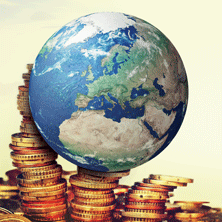 Global economic growth was lower than expected for the third consecutive year in 2013. In addition, the underlying dynamics of the global economy shifted, noted Galina Alexeenko, a director in the Atlanta Fed's Regional Economic Information Network (REIN), in "Global Economic Growth Falters...Again." Featured in the fourth-quarter 2013 issue of EconSouth, the article notes that developing economies, which had outperformed advanced economies during and after the recession, saw slower growth in 2013. Meanwhile, the advanced economies gathered momentum, Alexeenko wrote.
Global economic growth was lower than expected for the third consecutive year in 2013. In addition, the underlying dynamics of the global economy shifted, noted Galina Alexeenko, a director in the Atlanta Fed's Regional Economic Information Network (REIN), in "Global Economic Growth Falters...Again." Featured in the fourth-quarter 2013 issue of EconSouth, the article notes that developing economies, which had outperformed advanced economies during and after the recession, saw slower growth in 2013. Meanwhile, the advanced economies gathered momentum, Alexeenko wrote.
Economic prospects improved for the euro zone, with most of the growth powered by Germany and France. Even the fiscally troubled European countries—Greece, Ireland, Italy, Portugal, and Spain—worked towards their fiscal targets and implemented austerity measures and structural reforms. The economies of Japan and, to some extent, the United States also improved.
Developing economies didn't fare as well mostly because of the weak global economy in recent years. Flagging demand from advanced economies, along with slowing growth in China, dragged on developing economies, noted Alexeenko.
Even though global growth in 2013 failed to meet initially optimistic forecasts, the outlook for 2014 remains upbeat, if somewhat uncertain. The International Monetary Fund expects global growth to reach 3.6 percent in 2014, an improvement over the 2.9 percent growth estimated for 2013. Both developing and advanced economies should gain speed, but the emerging markets will outpace the developed world, again powering global growth.
Read the full article for more on the global economy in 2013 and the outlook for the upcoming year.


